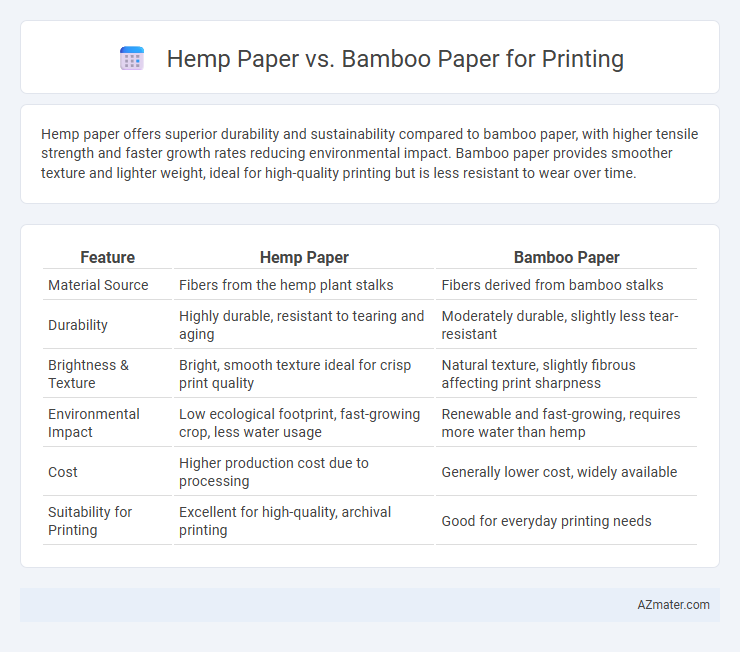Hemp paper offers superior durability and sustainability compared to bamboo paper, with higher tensile strength and faster growth rates reducing environmental impact. Bamboo paper provides smoother texture and lighter weight, ideal for high-quality printing but is less resistant to wear over time.
Table of Comparison
| Feature | Hemp Paper | Bamboo Paper |
|---|---|---|
| Material Source | Fibers from the hemp plant stalks | Fibers derived from bamboo stalks |
| Durability | Highly durable, resistant to tearing and aging | Moderately durable, slightly less tear-resistant |
| Brightness & Texture | Bright, smooth texture ideal for crisp print quality | Natural texture, slightly fibrous affecting print sharpness |
| Environmental Impact | Low ecological footprint, fast-growing crop, less water usage | Renewable and fast-growing, requires more water than hemp |
| Cost | Higher production cost due to processing | Generally lower cost, widely available |
| Suitability for Printing | Excellent for high-quality, archival printing | Good for everyday printing needs |
Introduction to Hemp and Bamboo Paper
Hemp paper, derived from the fibers of the cannabis plant, offers exceptional durability, resistance to yellowing, and sustainability due to rapid hemp growth and low environmental impact during cultivation. Bamboo paper, produced from fast-growing bamboo grass, is known for its smooth texture, high absorbency, and eco-friendly qualities stemming from bamboo's ability to regenerate quickly without pesticides. Both hemp and bamboo papers provide renewable alternatives to traditional wood pulp paper, with hemp excelling in strength and longevity while bamboo emphasizes softness and moisture control for printing applications.
Environmental Impact: Hemp vs Bamboo
Hemp paper generates significantly lower carbon emissions during production compared to bamboo paper, due to faster growth cycles and minimal pesticide use. Bamboo cultivation can lead to deforestation and biodiversity loss in certain regions, whereas hemp farming improves soil health and requires less water. Hemp paper's higher recyclability and biodegradability contribute to a more sustainable lifecycle than bamboo paper in printing applications.
Raw Material Availability and Sustainability
Hemp paper utilizes fibers from the Cannabis sativa plant, known for rapid growth and high yield per acre, making it a highly renewable raw material with minimal pesticide use. Bamboo paper is derived from fast-growing bamboo species that regenerate quickly and require less water and no replanting after harvesting, supporting sustainable forestry practices. Both offer eco-friendly alternatives to traditional wood pulp paper, but hemp's higher fiber strength and shorter growth cycle provide distinct advantages in sustainability and resource efficiency for printing applications.
Paper Production Process Comparison
Hemp paper production begins with retting, where hemp stalks are soaked to separate fibers, followed by mechanical or chemical pulping to extract long, durable fibers ideal for printing. Bamboo paper involves harvesting bamboo shoots, which undergo steaming or boiling to break down lignin before pulping, resulting in a smoother but shorter-fibered pulp. The different fiber structures affect the paper's strength and print quality, with hemp paper offering higher durability and bamboo paper providing a softer texture suitable for various printing needs.
Print Quality and Texture Differences
Hemp paper offers a smoother texture and higher durability, producing sharper and more vibrant print quality ideal for high-resolution images and fine text. Bamboo paper presents a slightly coarser texture, resulting in a more natural, earthy print appearance with slightly muted colors and less precision in detail. Print quality on hemp paper is generally superior for professional documents, while bamboo paper suits eco-friendly projects valuing texture and sustainability over sharpness.
Durability and Longevity in Printing
Hemp paper exhibits superior durability and longevity compared to bamboo paper due to its longer, stronger fibers that resist wear and tear during printing. The tensile strength of hemp fibers reduces paper degradation over time, making it ideal for archival documents and high-quality prints. Bamboo paper, while eco-friendly, tends to have shorter fibers that may lead to quicker deterioration and less resistance to frequent handling or exposure to environmental factors.
Cost Analysis: Hemp Paper vs Bamboo Paper
Hemp paper typically incurs higher production costs due to the longer processing time and specialized equipment needed to break down hemp fibers. Bamboo paper offers a more cost-efficient alternative as bamboo grows rapidly and requires less intensive pulping, resulting in lower raw material expenses. Despite initial price differences, hemp paper's durability and longevity can offset costs over time, while bamboo paper remains a budget-friendly option for high-volume, everyday printing needs.
Common Applications in Printing Industry
Hemp paper is widely used for eco-friendly printing projects, such as business cards, brochures, and stationery, due to its durability and high fiber content that results in a smoother finish and better ink absorption. Bamboo paper is favored for mass production of newspapers, packaging materials, and eco-conscious marketing materials because of its rapid renewability and cost-effectiveness. Both hemp and bamboo papers offer sustainable alternatives to traditional wood pulp paper, making them popular choices in green printing initiatives.
Consumer and Market Preferences
Hemp paper outperforms bamboo paper in durability and eco-friendliness, attracting environmentally conscious consumers seeking sustainable printing solutions. Market analysis shows hemp paper's higher tensile strength and longer fiber lifespan contribute to its preference in premium printing services and artisanal stationery. Bamboo paper appeals to budget-conscious buyers due to lower costs and faster production, though its market share lags behind hemp paper in niche eco-friendly segments.
Future Trends in Eco-Friendly Printing Papers
Hemp paper is gaining traction for eco-friendly printing due to its rapid growth cycle and minimal pesticide use, offering higher durability and recyclability compared to bamboo paper. Bamboo paper, valued for its softness and smooth texture, remains popular but faces scrutiny over energy-intensive processing techniques. Future trends indicate increased adoption of hemp-based paper in sustainable printing solutions driven by regulatory support, consumer demand for carbon-neutral products, and innovations reducing production costs.

Infographic: Hemp paper vs Bamboo paper for Printing
 azmater.com
azmater.com